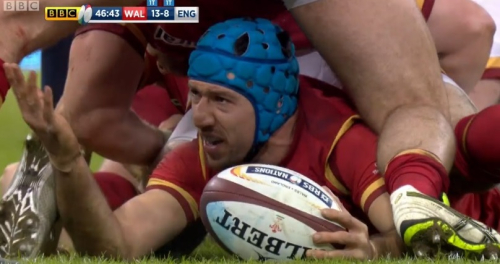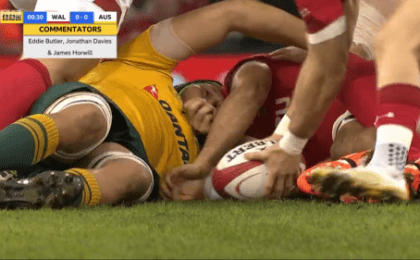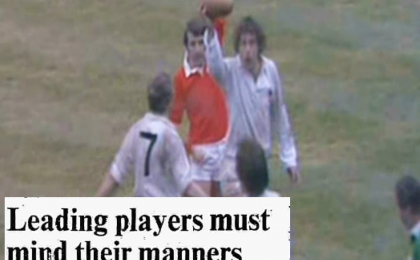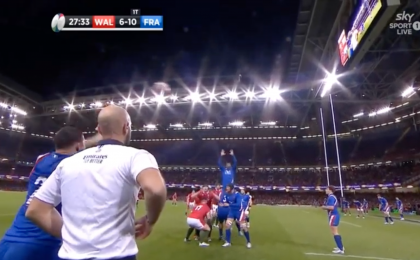UPDATE: (23/02/17) We contacted the BBC team for comment on this piece and provided a few questions for the broadcast team to try and get insight into the decision making process and reasoning behind the directing of the match broadcast feed. Sadly we were informed they were too busy ahead of the weekend’s rugby to get involved on this occasion.
Until around the 1960s there was little doubt watching a rugby match live in the ground was vastly superior to sitting at home on the sofa staring at an overheated, clunky glowing box.
By the 1970s though, the quality of live match coverage and camera work meant that even if television couldn’t replace the experience and emotion of a Championship game in the flesh, you could certainly have little to complain about when it came to seeing what was going on.
In the UK we’ve been fortunate to have the BBC cover what is now the Six Nations for generations. And for the first several decades its live television broadcast came with just a handful of cameras. Most match action came direct from just a couple of viewpoints and the focus was, well, on the ball. But as technology has improved and the number of cameras grown in abundance, it’s all got a little more complex.
The culture seems to have shifted from broadcasting a match to broadcasting an experience. Hi-definition video, ultra slow motion, multiple angles, ref cams, pitch microphones, and crowd/coach/VIP shots have all come together to offer endless permutations of how a game can be beamed into the nation’s bars and living rooms.
All of these innovations are fantastic on their own. The problem is the philosophy behind their employment. Instead of being used to enhance, they are being used to distract, wow and bedazzle. It seems more about immersing the viewer in the game (or what the director thinks is immersing the viewer in the game) than simply bringing the game to the viewer.
Camera angles that should be utilised wisely and occasionally for replays are being cut to during play with all the fanaticism of a hyperactive Paul Greengrass disciple. Replays that should be short, sharp and to the point are drawn out and often end up overlapping the subsequent set piece.
Go back and watch a BBC Five Nations broadcast in the 1980s. I guarantee you that you will have less live action missed than you do now (although to be fair, the BBC is far better than it was in the first decade of the 21st century when broadcasting a live lineout seem to have all the regularity of a good refereeing performance in the Pro 12).
Below, The South Terrace tackles a few of the most irritating trends in modern rugby broadcasting. We’d also love to get your feedback on what infuriates and delights you in this season’s Six Nations broadcasting (get us on Twitter at @theeastterrace).
Out of context, this is a nice shot. One can see why it appeals to broadcast directors. The problem is, in the live match context it’s distracting. Far too often this shot comes in and actually takes the viewer out of the game. You can’t see where the defence is, how the players are lined up in attack, what options are available to the halfback and so on.
Take the following passage of play. In the fourth minute England break into the Welsh 22 and have the home side on the back foot. Suddenly, Wales’ Dan Biggar forces a turnover. A huge momentum shift.
This is a classic example of when not to go to an extreme close up and shows a lack of appreciation for the game. Viewers want to see how the teams react. Is there a chance for a counter? Do England realign quick enough in defence and prevent a dart from a Welsh halfback? Will Wales look to clear or send a forward on a barge. It’s crucial the camera stays wide here.
Instead, we get this.
It’s about a five or six second shot. Enough to remove any indication to the viewer of what may be about to unfold.
Seconds later this happens again. Twice. England counter from the clearance kick and in the first two rucks we get two single second shots.
Both are such short cuts they do nothing but disrupt the visual narrative. The above clip isn’t just quick, it’s late. The broadcast team zoom in for the needless close up before having to quickly switch out again as the ball has already moved on
Mistakes happen. But once bitten, twice shy? Not a bit of it. The game is peppered with such short shots which miss the recycling of the ball and disorientate the viewer.
It really is relentless. At first The South Terrace planned to list the number of these ruck close ups that littered the game. We actually got fed up counting. It felt endless.
The opening play had 11 phases, five of them had ruck close ups. The last one (above) being my favourite.
These angles can be fantastic at the right time. But during live play is rarely the time to use them. They are best suited to being pulled out during stoppages to try and shine light on penalty calls or analyse intelligent rucking/counter rucking.
They also can add character. The below is a fantastic shot. Perfect for montages, replays, game commercials. Not so good for game context.
Frustratingly, when the close up camera did seem to offer something worth a replay, we never got it. Watching live, many viewers on Twitter expressed interest in this (very fleeting) shot.
Reckless use of the hands near the eyes? That’s very debatable (and the debate has raged online, believe me). But once shown it is never again brought up. So not only is use of this viewpoint generally distracting to viewers, when it potentially captures something of interest it is ignored.
Lining up the wrong replay
Rugby is a game overflowing with stoppages. There are enough breaks, resets, injuries, TMO calls and standing around to fill up with replays. Which is why missing lineouts and restarts is so infuriating.
Here’s a Welsh lineout in the seventh minute.
For fans who appreciate good forward play, it’s unforgivable. The lineout duel is one of the sport’s attractions. Who lines up where? Who marks who? What triggers the jump and throw? Fans want to watch these things.
Lineouts decide the momentum of a game. They decide result results. They decide titles. We shouldn’t have to miss them for moments that are gone.
Then, in contrast to the extreme close ups that plague the rucks, too many lineouts that are shown get broadcast like this:
Something is happening there. I’m damned if I know what though.
Just one more time
The curse of the replay doesn’t just impact lineouts either. Kick offs and conversions often fall pray to overzealous fascination with the past.
Here’s the Welsh conversion after Liam Williams’ try.
Admittedly, it was in front of the sticks. So we can understand, to a degree, the nonchalant concern of catching it live.
It’s not like test kickers ever miss them, is it?
The (right) picture tells a thousand words
The BBC has been, and continues to be, a great servant to the game and the vast majority of it’s live match broadcast work is first class.
The problem seems not to be ability, but philosophy. A modern obsession with providing an ‘immersive’ viewing experience actually takes the rugby fan out of the game, rather than propels them into it.
When the ball is in play, give us the wider picture. Leave the finer detail to be uncovered after the dust has settled.




